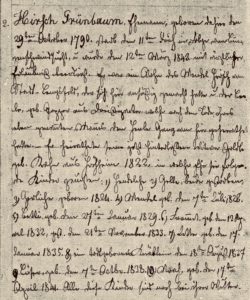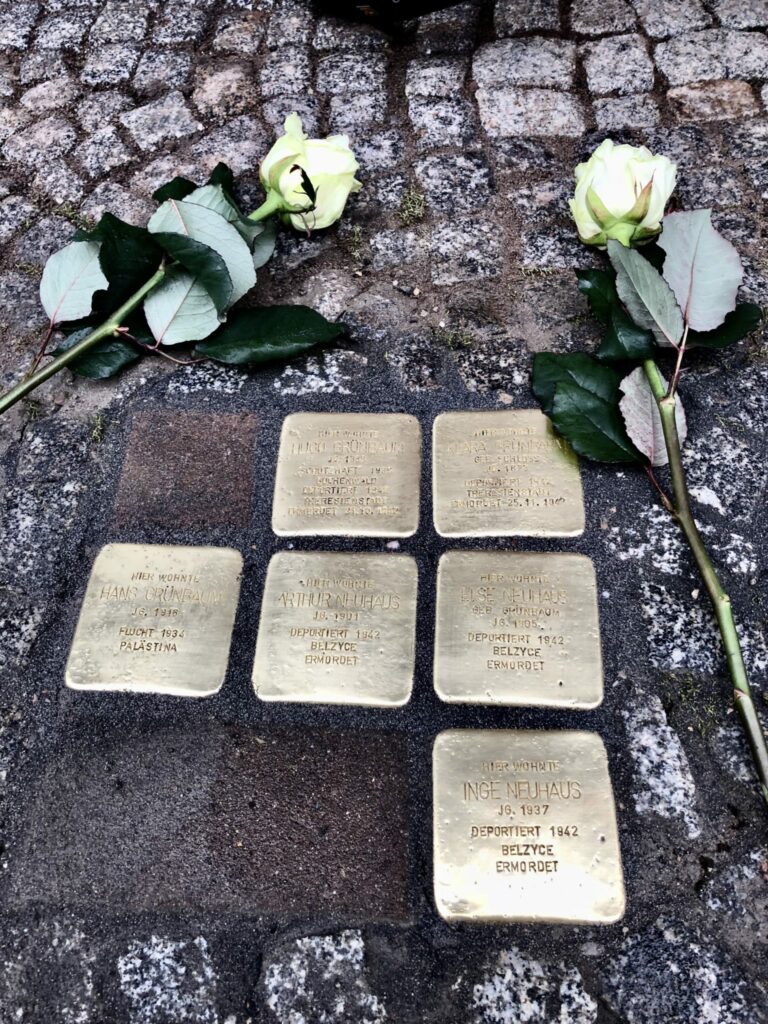The Families
1. Noah and 1) Minna and 2) Josefine Grünbaum
2. Hugo and Klara (née Schloß) Grünbaum
3. Minna (née Grünbaum) and Samuel Rosenthal
4. Karl and Hulda (née Schlesinger) Grünbaum
5. Abraham and Fanni (née Fuchs) Schlesinger
6. Löser and Johanna (née Bergmann) Grünbaum
7. Bertha (née Grünbaum) and Jacoby Seckel
8. Klara Wohgemuth, née Grünbaum
Descendants Lists
1. Hirsch and Golde (née Kohn) Grünbaum
2. Abraham and Veilchen (née. Lang) Schlesinger
3. Noah and 1) Minna and 2) Sophie Grünbaum
4. Heinrich and Ida (née. Schmalbach) Schloss
And also:
The Postcard Collection of Ilse Grünbaum
The Grünbaum family was one of the most important families for the Jewish community in Themar since its foundation in the early 1860s and until its dissolution in September 1942.
The first couple to come to Themar from the Grünbaum family was Noah and Minna, née Friedmann, Grünbaum. They were followed by Loeser and Johanna, née Bergmann, Grünbaum. Loeser and Noah were brothers, sons of Hirsch and Golde (née Kohn) from Walldorf an der Werra.
*****
The Grünbaum families of Themar trace their roots in Thüringen back to the 1780s in Walldorf/Werra and further back to Stadtlengsfeld; at the moment, we do not know where their earlier homes were. Mendel and Lenda Grünbaum came from Stadtlengsfeld to Walldorf/Werra sometime before 1790; their son Hirsch Grünbaum, the father of the families associated with Themar, was born on 29 October 1790 in Walldorf. The Jewish Register entry indicates that Hirsch was ‘one’ son of Mendel and Lenda, but as yet we have not identified siblings.
families associated with Themar, was born on 29 October 1790 in Walldorf. The Jewish Register entry indicates that Hirsch was ‘one’ son of Mendel and Lenda, but as yet we have not identified siblings.
In 1822, Hirsch Grünbaum married Golde Kohn; they had a total of 10 children, of whom seven (7) were still alive at the time of Hirsch’s death in 1843. See The Descendants List of Hirsch and Golde (née Kahn) Grünbaum
The two members of Hirsch’s and Golde’s family about whom we know most are the two sons who came to Themar: Löser Grünbaum, b. 1838, and his younger brother, Noah, b. 1841. They moved to Themar in the late 1860s/early 1870. The small city—its location, its trading routes by train and water, and its role as an administrative centre—offered greater opportunities for economic prosperity than did Walldorf/Werra. The Jewish community in Walldorf/Werra was in decline: in the first half of the 19th century the community had grown from 238 in 1810 to 562 in 1849 (34% of the town’s population of 1637), but then the number had started to fall; by close to 100 by 1855 and then in a flood by the end of the century when only 108 Jews lived in Waldorf.
Both Löser and Noah decided to stay in Germany and in their home state of Sachsen-Meiningen (as Thüringen was then known). Both men were relatively young, in their thirties, and married with children when they made the move. Both men remained in Themar for the rest of their lives: Noah died first in January 1901; Löser died three years later. Both men and their families had made significant contributions to the life of Themar.
*****
The story of the Grünbaum family in Themar contributes much to our understanding of the dynamics of the small city of Themar in the late 1800s/early 1900s. We learn more about one of Themar’s ‘core’ Jewish families, the Grünbaums, members of whom were in Themar from the beginning in the late 1860s/early 1870s until the destruction of the Jewish community in the Holocaust. It tells us how the rapid growth of the Jewish community was primarily the result of in-migration of Jews from other communities rather than natural increase. We learn more about the internal dynamics of Themar’s economic structure: how Jewish businesses were established, closed, and/or passed into the hands of other family members.
Within a larger context, the family’s story contributes to our knowledge of why and how many German families — Jewish and non-Jewish — changed location, moving within their home state from one urban centre to another, perhaps the same size, frequently larger, and then still larger in search of economic prosperity, or left Germany altogether.
And, with particular reference to the experience of Jewish families during the Holocaust, the story of the Grünbaums highlights the strategies families pursued in order to escape the Nazi terror. In so doing, the story challenges some long-standing assumptions about Jewish Germans — such as the belief that older Jewish Germans resisted or refused to consider emigration.
*****
On 27 November 2019, Stolpersteine were laid to honour the members of the Grünbaum family — descendants of Noah and Minna (née Friedmann) Grünbaum — in front of their last freely-chosen home at Bahnhofstrasse 23. Garry Meller, a grandson of Noah and his second wife, Josephine/Sophine, travelled from Australia to Themar, to represent the family at this ceremony.

We would like to thank the families of Karl and Hulda Grünbaum, their children and grandchildren, who have shared their family archives with us.
If you have any information or questions about the Grünbaum families of Themar, which you would like to share, please contact Sharon Meen
@ [email protected] or [email protected]. We would be pleased to hear from you.> or [email protected]. We would be pleased to hear from you.